How To Replace Heater Hose
Heater Hose Replacement
Car Heater Hose
Helpful Information
Heater hoses transfer hot engine coolant into the heater core where it's processed into warm air and utilized by the heater system. Some systems are designed with a fluid control valve which stops coolant from flowing into the core which should also be replaced with the hose set. Heater hoses should be inspected for wear and failures when inspecting other coolant hoses such as the radiator hoses. Occasionally the heater core will trap air inside (post repair) the core producing abubbling noise which should dissipate.
Best Practices
- Always clean the hose sealing surface (fitting) to ensure a good seal.
- Replace hose clamps with new units.
Step by step guide on how to replace automotive engine heater hoses, this article pertains to most vehicles.
Difficulty Scale: 4 of 10
Tools and Supplies Needed
Begin with the engine cold, in park with the emergency brake set, drain the cooling system.
Step 1 - Locate the heater hoses to be replaced and remove or relocate any obstructions.
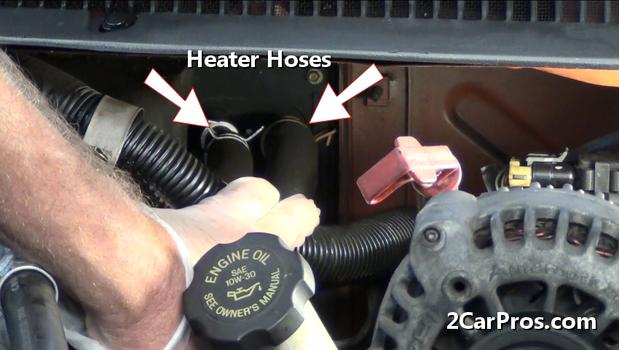
Locate Heater Hoses
Step 2 - Some vehicles use a spring loaded hose clamp which can be removed by using a special hose clamp removal tool, a pair of pliers can also be used. A worm screw style of clamp will use a screw driver to remove.
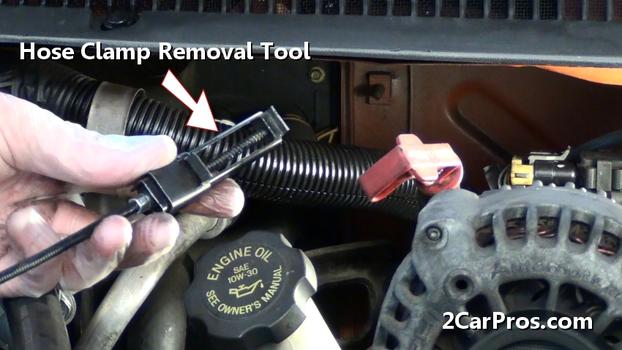
Hose Clamp Removal Tool
Step 3 - Once the tool has been installed, move the hose clamp to gain access to the hose mounting fitting. (Note: Heater hoses are connected to the heater core, this core is fragile so caution should be used when removing the heater hoses to avoid breaking the core and causing a coolant leak.)

Hose Clamp Removed
Step 4 - After the hose clamps have been loosened and relocated down the hose, use an exacto knife or razor blade to gently slice the hose long ways along the fitting.

Exacto Knife
Step 5 - Once the heater hose has been cut, gently lift and twist the hose to release it from the heater core fitting, repeat this process for the remaining hose.
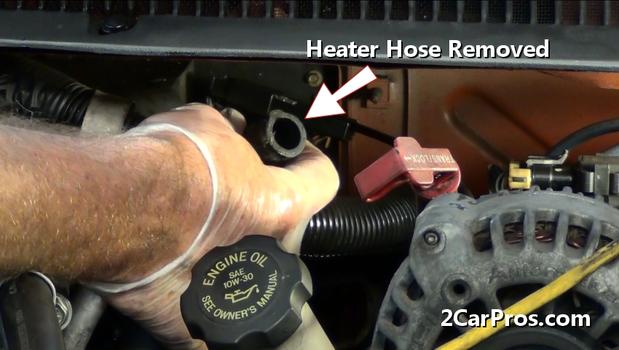
Heater Hose Removed
- Replacement hoses
- Hose clamp tool
- Engine coolant
- Fluid catch basin
- Socket set
- Flashlight
- Pliers
- Exacto knife or razor blade
- Protective eyewear and gloves
Begin with the engine cold, in park with the emergency brake set, drain the cooling system.

Locate Heater Hoses
Step 2 - Some vehicles use a spring loaded hose clamp which can be removed by using a special hose clamp removal tool, a pair of pliers can also be used. A worm screw style of clamp will use a screw driver to remove.

Hose Clamp Removal Tool

Hose Clamp Removed

Exacto Knife

Heater Hose Removed
Step 6 - Next, locate and remove the heater hoses from the engine which are usually near the engine water pump.
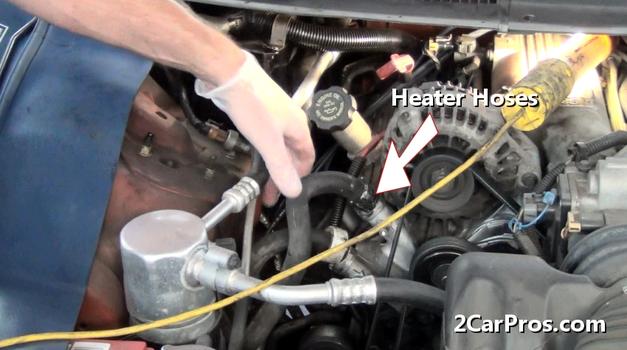
Heater Hoses Engine Side
Step 7 - After the hoses have been released from the heater core and engine, remove any remaining mounting hardware and remove the hoses from the engine bay.
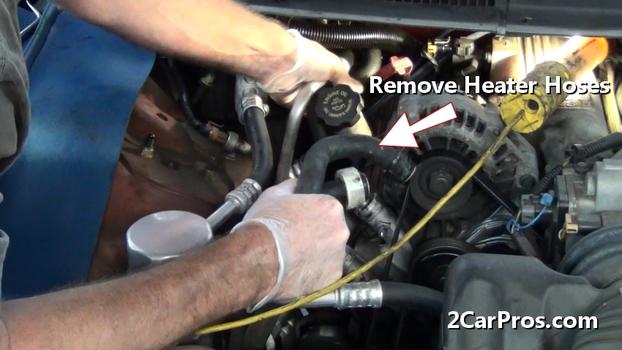
Removing Heater Hoses
Step 8 - It can take a little ingenuity to configure the hoses for removal.
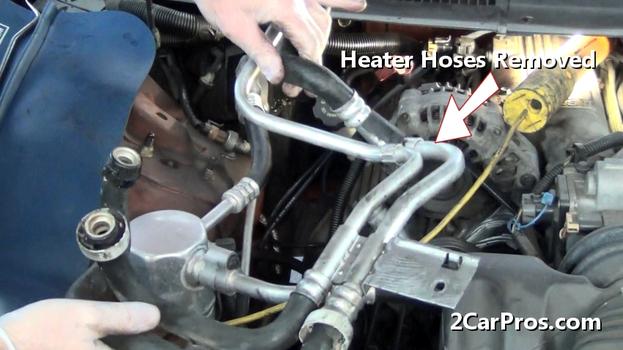
Heater Hoses Removed
Step 9 - Once the heater hoses have been removed, use a shop towel to clean the heater hose fittings to help seal the new hose installation.

Clean Heater Hose Fittings
Step 10 - Compare the worn heater hose set to the replacement hoses to ensure a proper installation.

Match Up Heater Hoses

Heater Hoses Engine Side

Removing Heater Hoses

Heater Hoses Removed
Step 9 - Once the heater hoses have been removed, use a shop towel to clean the heater hose fittings to help seal the new hose installation.

Clean Heater Hose Fittings

Match Up Heater Hoses
Step 11 - After comparing the new hose set, install the hoses into the engine bay.

Install New Heater Hoses
Step 12 - Once the heater hoses have been placed into the engine bay, connect the hoses to the engine using new hose clamps.
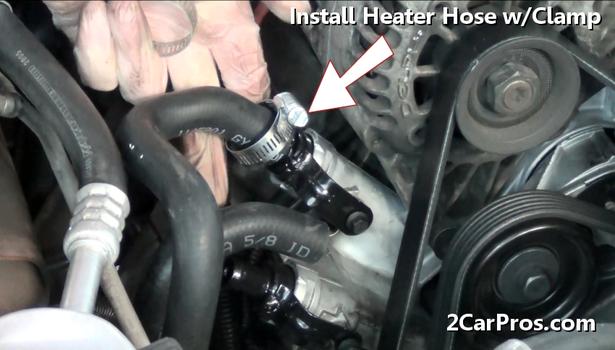
Installing New Heater Hoses
Step 13 - Next, position the hose clamp over the middle of the hose fitting and tighten securely, repeat this process for the remaining hose.

Tighten Hose Clamp
Step 14 - After the hoses are installed and clamps tightened, inspect for obstructions such as metal shielding that can damage the hose and relocate to prevent damage to the hose.
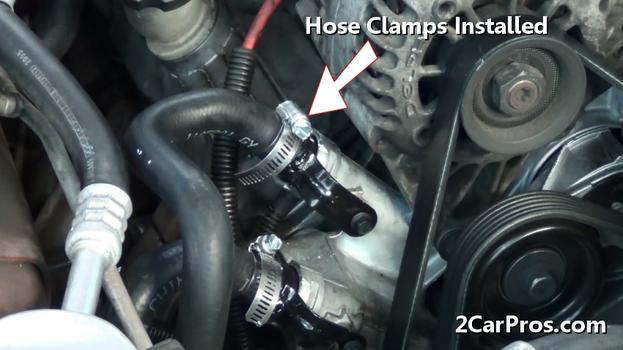
Heater Hose Clamps Installed
Step 15 - Connect the remaining hose ends onto the heater core fittings using a hose clamp tool to activate the clamp.
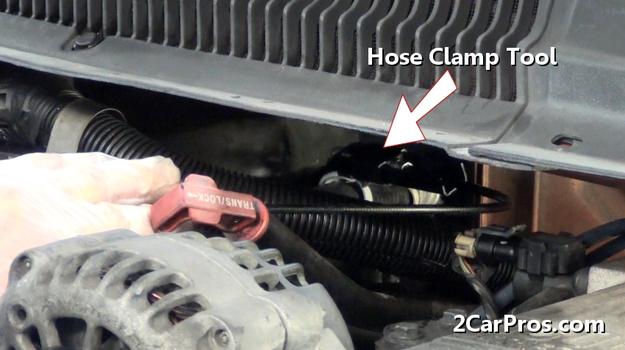
Hose Clamp Tool

Install New Heater Hoses

Installing New Heater Hoses

Tighten Hose Clamp
Step 14 - After the hoses are installed and clamps tightened, inspect for obstructions such as metal shielding that can damage the hose and relocate to prevent damage to the hose.

Heater Hose Clamps Installed

Hose Clamp Tool
Step 16 - It helps to activate the clamp tool before attaching the hose to the fitting. (Note: Do not use lubricant to aid hose installation as it may cause it to prematurely fail.)

Installing Heater Hoses to Core
Step 17 - Once the heater hose connections are complete, refill the cooling system.

Installing Engine Coolant
Once the job is complete, and the radiator is being refilled, start the engine and allow to warm up to operating temperature (thermostat open) and top off with coolant, then reinstall the radiator cap. Once the car has been driven, check for coolant leaks and recheck the coolant reservoir fluid level.
Related Car Repair Information

Installing Heater Hoses to Core

Installing Engine Coolant
Related Car Repair Information
My heater has been acting funny lately, and I am trying to get it ready for the winter. I think it might be one of the hoses that might be the cause of my troubles. I've never actually replaced one before, so your article is going to be a big help to me. I will definitely to be sure to get a clamp removal tool to make the job a lot easier. Thanks for the awesome post. http://www.bristolheatingandair.com
ReplyDelete